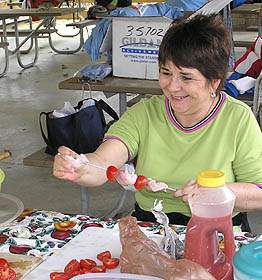
Here are some excerpts from previously published Homing In articles about organizing and executing the USA national and International Amateur Radio Union (IARU) Region 2 ARDF Championships. Beginning in 2020, a Sanctioning Subcommittee of the ARRL ARDF Committee gives approval for all championship ARDF events in the USA. For information about applying to host the USA ARDF Championships, contact the committee by e-mail at ardf@arrl.org.

![]() IARU rules call for separate 2-meter and 80-meter "classic" competitions are to be held on separate days. They should be at different sites, or in different parts of a single large site. An area of 800 acres or more is needed for each site. Separate accessible locations are needed for start and finish. Transmitters must be at least 400 meters apart and more than 400 meters from the finish. No transmitter shall be less than 700 meters from the start. The Pacific Northwest has an abundance of outstanding possibilities. Other areas of the country, such as the woods of the northeast, the Appalachian Mountains and the moss-covered trees of the south are quite good. Even mountainous parts of desert states like Arizona and New Mexico have suitable radio-orienteering sites. The entire location doesn't have to be forested. Sometimes portions of championship orienteering courses include farm land or open grass. Almost every state has at least one site where an IARU ARDF event could be held.
IARU rules call for separate 2-meter and 80-meter "classic" competitions are to be held on separate days. They should be at different sites, or in different parts of a single large site. An area of 800 acres or more is needed for each site. Separate accessible locations are needed for start and finish. Transmitters must be at least 400 meters apart and more than 400 meters from the finish. No transmitter shall be less than 700 meters from the start. The Pacific Northwest has an abundance of outstanding possibilities. Other areas of the country, such as the woods of the northeast, the Appalachian Mountains and the moss-covered trees of the south are quite good. Even mountainous parts of desert states like Arizona and New Mexico have suitable radio-orienteering sites. The entire location doesn't have to be forested. Sometimes portions of championship orienteering courses include farm land or open grass. Almost every state has at least one site where an IARU ARDF event could be held.
![]() The national championships should also include sprint and foxoring events on one or more separate days. These 80-meter events should take place in locations that are separate from the classic event sites.
The national championships should also include sprint and foxoring events on one or more separate days. These 80-meter events should take place in locations that are separate from the classic event sites.
![]() Electronic scoring is far superior to the old pin-punch-and-card system because it gives exact arrival times for each competitor at each fox and and automates the tallying of results. If your local orienteering club cannot supply e-punch equipment, it can probably be obtained from another club. Contact the ARDF Coordinator for more information.
Electronic scoring is far superior to the old pin-punch-and-card system because it gives exact arrival times for each competitor at each fox and and automates the tallying of results. If your local orienteering club cannot supply e-punch equipment, it can probably be obtained from another club. Contact the ARDF Coordinator for more information.
![]() Good maps are a must. Most foxhunting champions are also skilled orienteers, expecting detailed topographical maps with contour lines at elevation intervals and accurate depiction of vegetation. Local orienteering clubs may already have up-to-date maps for suitable areas. Older maps should be field-checked and updated before the event. It may be possible to create suitable maps using USGS data from the Internet. Computer programs such as OCAD can also be used. Some older OCAD versions are available for free.
Good maps are a must. Most foxhunting champions are also skilled orienteers, expecting detailed topographical maps with contour lines at elevation intervals and accurate depiction of vegetation. Local orienteering clubs may already have up-to-date maps for suitable areas. Older maps should be field-checked and updated before the event. It may be possible to create suitable maps using USGS data from the Internet. Computer programs such as OCAD can also be used. Some older OCAD versions are available for free.
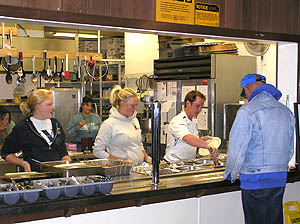
![]() Most first-time foxhunt organizers worry most about obtaining the properly-timed transmitters. Those are indispensable of course, but they may be readily available for loan from a local ham or someone who will be attending. A controller, handi-talkie and battery in an ammunition box is all it takes for two meters. Replace the handi-talkie with a simple 80-meter transmitter board to convert the box for that band.
Most first-time foxhunt organizers worry most about obtaining the properly-timed transmitters. Those are indispensable of course, but they may be readily available for loan from a local ham or someone who will be attending. A controller, handi-talkie and battery in an ammunition box is all it takes for two meters. Replace the handi-talkie with a simple 80-meter transmitter board to convert the box for that band.
![]() It is an IARU tradition that foreign radio-orienteers are welcome to compete at national championships and out-of-region radio-orienteers are sought at regional championships. These visitors compete as individuals, not in national teams. Our championships should be scheduled well in advance so that foreigners can be notified and can make travel plans. The organizers may need to assist with formal invitations to help participants from some countries obtain visas to enter the USA.
It is an IARU tradition that foreign radio-orienteers are welcome to compete at national championships and out-of-region radio-orienteers are sought at regional championships. These visitors compete as individuals, not in national teams. Our championships should be scheduled well in advance so that foreigners can be notified and can make travel plans. The organizers may need to assist with formal invitations to help participants from some countries obtain visas to enter the USA.
![]() When ARDF enthusiasts converge from many states and countries, it's important to have them stay close together and interact on a continuous basis to form lasting friendships. The most cost-effective group accommodations may be found at schools and colleges. For instance, the 2001, 2003 and 2005 USA Championships were headquartered at colleges in New Mexico and Ohio. For the 2007 championships near South Lake Tahoe, competitors could stay in cabins adjacent to the competition sites and eat all meals in a group setting. If this is not practical, suggestions should be provided for suitable nearby hotels, motels and restaurants, with one hotel designated as the "event hotel."
When ARDF enthusiasts converge from many states and countries, it's important to have them stay close together and interact on a continuous basis to form lasting friendships. The most cost-effective group accommodations may be found at schools and colleges. For instance, the 2001, 2003 and 2005 USA Championships were headquartered at colleges in New Mexico and Ohio. For the 2007 championships near South Lake Tahoe, competitors could stay in cabins adjacent to the competition sites and eat all meals in a group setting. If this is not practical, suggestions should be provided for suitable nearby hotels, motels and restaurants, with one hotel designated as the "event hotel."
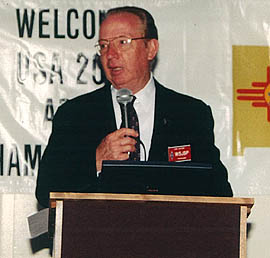
![]() It's likely that the competition sites won't be adjacent to where competitors will be eating and sleeping. You may need to arrange bus or carpool transportation for each competition day. That insures that everyone arrives at the site on time with no lost souls. Box lunches for these days are a nice touch, but not mandatory.
It's likely that the competition sites won't be adjacent to where competitors will be eating and sleeping. You may need to arrange bus or carpool transportation for each competition day. That insures that everyone arrives at the site on time with no lost souls. Box lunches for these days are a nice touch, but not mandatory.
![]() Besides lodging and food, there should be a meeting room and social area for registration and a pre-hunt briefing. Consider having a special event ham station for visitors to operate in free time. Internet access would be a big plus, as visitors will want to send e-mail to their families and friends at home.
Besides lodging and food, there should be a meeting room and social area for registration and a pre-hunt briefing. Consider having a special event ham station for visitors to operate in free time. Internet access would be a big plus, as visitors will want to send e-mail to their families and friends at home.
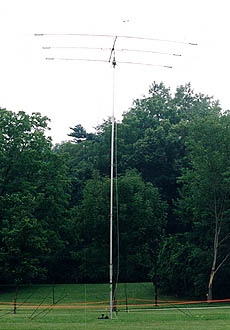
![]() It takes a team of volunteers to put on a well-run ARDF competition. At the starting line, helpers make sure that competitors receive their maps at ten minutes before their starting time and can tape them to their map boards. Then at five minutes before the start, they move up to the starting line, where volunteers make sure that they have competitor cards or that they clear and check their e-punch "sticks." Then they send off the hunters at exact five-minute intervals in the order previously drawn by lot. Helpers at the finish line announce incoming competitors, collect the cards and mark finishing time on them, or download the e-punches. They also offer refreshments and first aid where needed. Things can get hectic at these two locations, so several persons are better than one. Remember that these positions do not require licensed hams. See the bottom of this page for files with more information about start/finish procedures.
It takes a team of volunteers to put on a well-run ARDF competition. At the starting line, helpers make sure that competitors receive their maps at ten minutes before their starting time and can tape them to their map boards. Then at five minutes before the start, they move up to the starting line, where volunteers make sure that they have competitor cards or that they clear and check their e-punch "sticks." Then they send off the hunters at exact five-minute intervals in the order previously drawn by lot. Helpers at the finish line announce incoming competitors, collect the cards and mark finishing time on them, or download the e-punches. They also offer refreshments and first aid where needed. Things can get hectic at these two locations, so several persons are better than one. Remember that these positions do not require licensed hams. See the bottom of this page for files with more information about start/finish procedures.
![]() ARDF is an amateur sport, so cash prizes are not offered at national or international championships. It is traditional to have first, second and third place or other token awards in all age/gender categories for the best individuals on each band. Awards are typically presented at the banquet by a VIP of ARRL or IARU. Your ARDF Coordinator can assist with invitations to the VIPs.
ARDF is an amateur sport, so cash prizes are not offered at national or international championships. It is traditional to have first, second and third place or other token awards in all age/gender categories for the best individuals on each band. Awards are typically presented at the banquet by a VIP of ARRL or IARU. Your ARDF Coordinator can assist with invitations to the VIPs.
![]() Sponsoring an international radio-orienteering event isn't a moneymaking venture, but it shouldn't deplete the club treasury either. Carefully consider all the costs, set a reasonable competitor fee, and announce it well in advance. Typically, the basic fee covers cost of the competition, medals, some meals, supplies, and event T-shirts. In some cases, lodging and/or transportation is included.
Sponsoring an international radio-orienteering event isn't a moneymaking venture, but it shouldn't deplete the club treasury either. Carefully consider all the costs, set a reasonable competitor fee, and announce it well in advance. Typically, the basic fee covers cost of the competition, medals, some meals, supplies, and event T-shirts. In some cases, lodging and/or transportation is included.
![]() Selection of sites and arranging for housing are substantial undertakings, but you don't have to do them alone. Your local Chamber of Commerce or Convention/Visitor's Bureau may have good suggestions. The National Park Service and the forestry authorities in your state can be of assistance in site selection.
Selection of sites and arranging for housing are substantial undertakings, but you don't have to do them alone. Your local Chamber of Commerce or Convention/Visitor's Bureau may have good suggestions. The National Park Service and the forestry authorities in your state can be of assistance in site selection.
![]() Get to know the leaders of your local orienteering club. They can probably supply the standard orange-and-white flags, stands and unique punches for each fox, plus electronic scoring equipment. They will also have excellent ideas for suitable well-mapped sites. They may even volunteer to assist with the event as course-setters, course marshals and timers.
Get to know the leaders of your local orienteering club. They can probably supply the standard orange-and-white flags, stands and unique punches for each fox, plus electronic scoring equipment. They will also have excellent ideas for suitable well-mapped sites. They may even volunteer to assist with the event as course-setters, course marshals and timers.
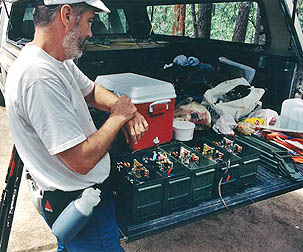
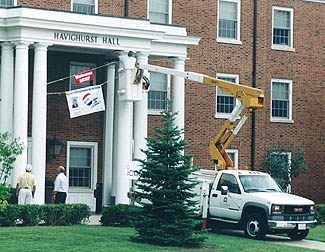
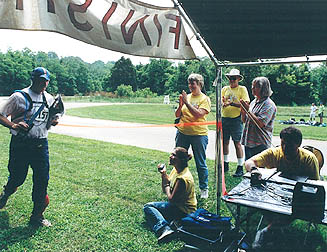
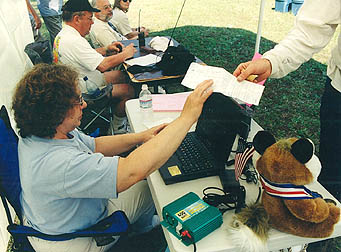
![]() The following instruction files were created by the organizers of the 2011 championships near Albuquerque. While they are specific to those events, they are also a good general resource for organizers, particularly regarding the details of starting line procedures.
The following instruction files were created by the organizers of the 2011 championships near Albuquerque. While they are specific to those events, they are also a good general resource for organizers, particularly regarding the details of starting line procedures.
 Back to the Championship Foxhunting News page
Back to the Championship Foxhunting News page
Back to the Homing In home page
 This page updated 10 July 2025
This page updated 10 July 2025